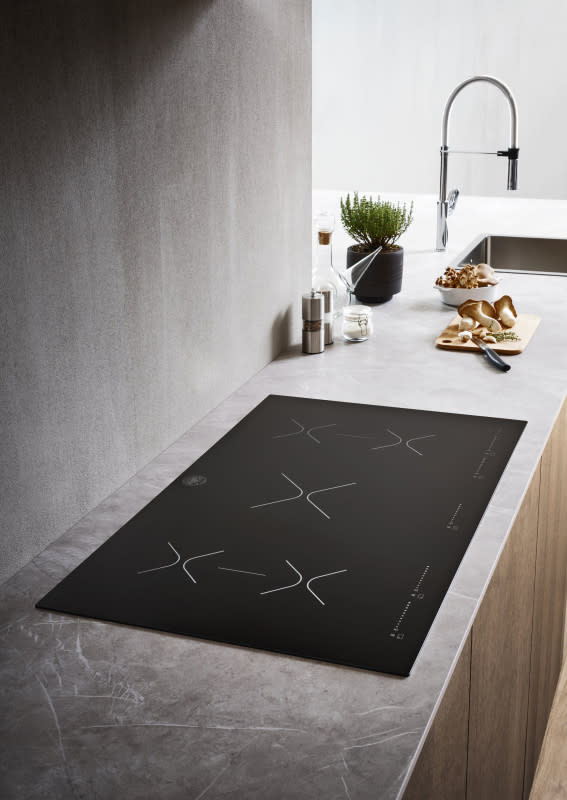How to Clean an Induction Cooktop
An induction cooktop is a wonderful kitchen appliance that creates a sleek aesthetic while offering a precise and energy-efficient cooking experience; however, like all glass cooktops, they have a tendency to show fingerprints, smudges, and build up with a fine, smooth top layer of residue from cooking. Regular cleaning is recommended to keep them looking pristine. Learn more about practical methods, DIY cleaners, and what tools to avoid to ensure your cooktop stays in great condition.
Using a Store-Bought Cleaner
Gather cleaning supplies. Gather the necessary supplies, including a store-bought liquid spray cleaner specifically designed for induction cooktops, a cream cleaner, soft microfiber cloths, non-abrasive sponges, and a plastic scraper (optional).
Turn off and cool down the countertop. Ensure that the cooktop is turned off and completely cooled down before starting the cleaning process. Cleaning a hot surface is not safe.
Remove loose debris. Use a damp sponge or soft cloth to gently remove any dried-on food bits, grease splatter, or food spills.
Apply liquid spray cleaner. If using a liquid spray cleaner, apply it evenly across the entire surface. Follow the manufacturer's instructions on the product for the best results.
Let the cleaner sit. Allow the liquid cleaner to sit on the surface for the recommended time specified on the product packaging—a few minutes go a long way. This gives the cleaner time to break down grease and stubborn stains.
Wipe the cleaner with a microfiber cloth. Use a soft microfiber cloth to wipe away the cleaner, along with the dissolved dirt and grime. Wipe the surface with warm water and then dry with a clean cloth.
Apply a cream cleaner for tough residue. For remaining burned-on residue, use an approved cream cleaner for its abrasive properties. Apply a small amount of cream cleaner directly onto the affected areas as per the product’s instructions.
Firmly scrub the cream in a circular motion. Rub the tough residue using a non-abrasive sponge or a plastic scraper. Focus on persistent spots but be cautious not to scratch the surface.
Wipe the cream off the surfaces. Wipe the cooktop again with a clean, damp microfiber cloth to remove any remaining cleaner or residue.
Buff for shine. Buff the induction cooktop with a dry microfiber cloth in a circular motion to achieve a spotless finish and prevent water stains.
When it comes to tackling tough burnt-on residue, we recommend patience and trusting that the cleaners will work in due time. Some sources suggest using a razor held at a low angle. We do not recommend this as we have found that it is too easy to scratch the surface and your warranty may not cover the damage. If you feel that the burnt residue requires a glass scraper, consult your cooktop's manual or website for their recommended product.
Using a DIY Cleaning Solution
If you want to use what you have on hand, there are a few simple options.
White Vinegar Solution
Mix equal parts white vinegar and water in a spray bottle.
Spray the vinegar mixture on the cooktop surface and let it sit for five minutes.
Wipe away with a clean microfiber cloth.
Baking Soda Paste
This option is especially good for burned-on residue as the mild abrasive nature of baking soda helps break down and lift stubborn, messy food grime.
Mix baking soda with a small amount of water to make a paste.
Apply the paste to tough stains or burned-on residue.
Gently scrub with a non-abrasive sponge and wipe clean.
Lemon and Dish Soap Mixture
Squeeze the juice of one lemon into a bowl and add a few drops of liquid dish soap.
Mix well and dip a soft cloth into the mixture.
Lay the damp cloth on the glass cooktop’s stains. Allow it to sit for a few minutes.
Wipe off the surface with a clean microfiber cloth and warm water. Dry and buff to a shine.

Bertazzoni
How to Prevent Burnt Food and Residue on Burners
Prevent a mess before it starts. Protect your cooktop from foods that splash or splatter (i.e. sauces, searing meats, rapidly boiling jams/jellies) by placing a paper towel or cloth napkin under the pot to catch splatters. It’s our favorite feature of induction technology and it makes cleanup a breeze!
Clean regularly. As soon as your cooktop has cooled down, give it a quick once-over. Do this every time you cook. Prompt cleaning prevents residues from hardening and becoming difficult to remove.
Use a lid when appropriate. Maybe it goes without saying, but the less splatter that’s created, the less opportunity for gunk to burn on. A few simple steps now will save you from a deeper cleaning later.
FAQ
What Cleaning Tools Should I Avoid?
Abrasive scrubbers. Avoid anything with metal mesh, scouring/abrasive scrubbing pads, or harsh bristles. These can scratch the smooth glass surface, compromising its functionality and appearance.
Harsh chemicals. Bleach, oven cleaners, and ammonia are all big no-nos for induction cooktops. Their aggressive formulas can damage the glass and leave unsightly white marks!
Paper towels. While seemingly convenient, paper towels can leave behind tiny fibers that can trap dirt and grime. Stick to microfiber cloths for effective and streak-free cleaning.
Can you use Windex or glass cleaner to clean an induction cooktop?
No. Using Windex or glass cleaner on an induction cooktop is generally not recommended. These cleaners may leave residues, streaks, or contain chemicals that are not compatible with the ceramic glass surface of induction cooktops. Some glass cleaners may have abrasives that could scratch the cooktop, and the high temperatures that the residues are subjected to during cooking is not good to breathe. Use cleaners specifically designed for induction cooktops or follow DIY options like a white vinegar and water mixture or a baking soda paste. Always refer to the user manual for manufacturer-recommended cleaning methods to ensure the safe and proper care of your induction cooktop.
